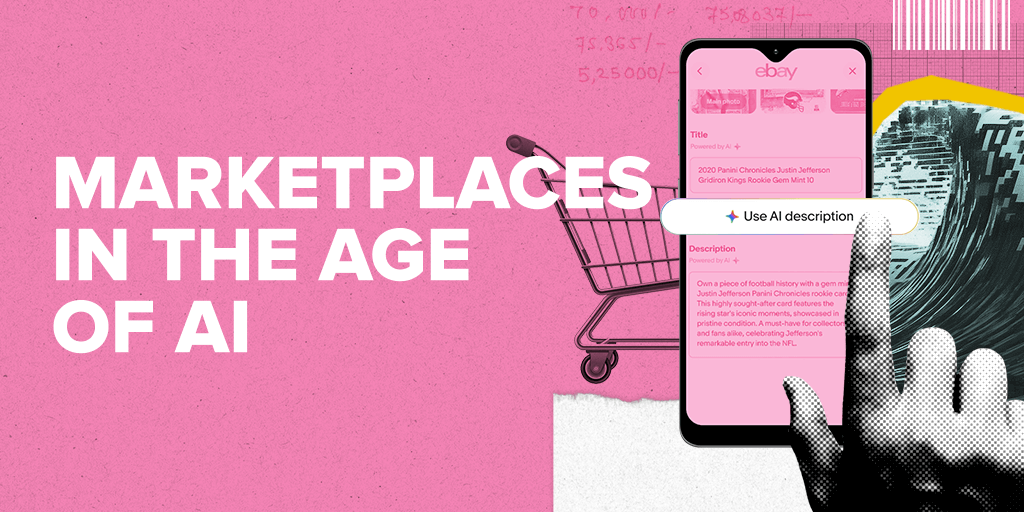The Impact of AI on Marketplaces: Opportunities and Challenges
Core Concepts
Generative AI is set to revolutionize marketplaces by transforming how products are sold and made, impacting both buyers and sellers significantly.
Abstract
In the age of AI, marketplaces are undergoing a transformation that promises to enhance user experiences and streamline transactions. Generative AI is expected to revolutionize marketplaces by changing how products are sold and made. Buyers will benefit from new search modalities, custom supply creation, negotiation assistance, and improved customer service. On the other hand, sellers will see increased efficiency through automation of tasks like listing creation and customer service. Legacy marketplaces may need to pivot or face challenges from emerging opportunities as AI reshapes the marketplace landscape.
Marketplaces in the Age of AI | Andreessen Horowitz
Stats
Pietra's AI tool already accounts for 40% of custom manufacturing requests.
eBay's Magic Listing tool saw 95% of sellers using the AI description in early testing.
Incredible Health's Resume Wizard helps nurses create optimized resumes in five minutes.
Quotes
"AI should drive more liquid and more stable marketplaces — with more listings, higher conversions to transaction, and more repeat purchases than ever before."
"If you’re reinventing your marketplace with genAI, or building something new, reach out."
Key Insights Distilled From
by Olivia Moore at a16z.com 12-14-2023
https://a16z.com/marketplaces-in-the-age-of-ai/
Deeper Inquiries
How can legacy marketplaces effectively pivot to embrace AI without losing their core identity?
Legacy marketplaces looking to integrate AI into their operations need to approach the transition strategically. One key aspect is maintaining a balance between leveraging AI for efficiency and personalization while preserving the unique characteristics that define their brand. To effectively pivot, legacy marketplaces should consider the following steps:
Identify Core Values: Legacy marketplaces must first identify what sets them apart from competitors and what values they want to preserve throughout the integration of AI.
Gradual Implementation: Instead of implementing AI across all aspects at once, legacy marketplaces can start with specific areas where AI can enhance user experience or streamline processes.
User Feedback: Continuous feedback from users during the transition phase is crucial in ensuring that any changes align with customer expectations and preferences.
Training & Development: Providing training for existing staff on how to work alongside AI tools will be essential in maintaining a cohesive human-AI workforce.
Customized Solutions: Tailoring AI solutions to complement rather than replace human interaction can help maintain the personalized touch that users value in legacy marketplaces.
By carefully navigating these steps, legacy marketplaces can successfully pivot towards embracing AI while retaining their core identity and customer base.
Is there a risk that AI could devalue personalized digital content created by celebrities on platforms like Cameo?
There is indeed a risk associated with using AI in creating personalized digital content on platforms like Cameo where authenticity and uniqueness are highly valued by users. The potential risks include:
Loss of Authenticity: If deepfake technology becomes advanced enough, it could create replicas of celebrities' performances or messages, leading to doubts about the authenticity of content generated through such means.
Diminished Value Perception: Users may perceive digitally generated content as less valuable compared to authentic creations made by celebrities themselves, potentially impacting engagement levels and willingness to pay for such content.
Ethical Concerns: The use of deepfake technology raises ethical concerns regarding consent, privacy, and misrepresentation if not regulated properly within these platforms.
To mitigate these risks, platforms like Cameo should establish clear guidelines on the use of AI-generated content, ensure transparency about its creation process when utilized, prioritize authenticity in celebrity interactions with fans over automated responses wherever possible.
How can marketplaces balance the use of AI tools while maintaining the human touch that users value?
Maintaining a delicate balance between leveraging AI tools for efficiency and preserving human touch is crucial for marketplace success in an increasingly automated landscape:
Hybrid Approach: Implementing an approach where humans work alongside intelligent machines allows for combining automation benefits with personalized service delivery.
Personalization: Utilize data-driven insights from AI algorithms to tailor recommendations or services based on individual user preferences while still allowing room for human intervention when needed.
3 .Transparency: Clearly communicate when interactions involve automated processes versus direct human involvement so users feel informed about who they are engaging with.
4 .Feedback Mechanisms: Regularly gather feedback from users regarding their experiences interacting with both automated systems and humans; this input helps refine strategies balancing tech-driven efficiencies with personal touches.
5 .Empathy Training: Provide training programs focused on enhancing empathy skills among employees handling customer interactions; this ensures that even amidst automation advancements, customers receive empathetic responses when required.
6 .Continuous Improvement: Strive towards continuous improvement by analyzing user behavior patterns influenced by both automated features and human interventions; adjust strategies accordingly based on performance metrics gathered over time.
By adopting these strategies proactively, marketplace operators can strike a harmonious equilibrium between utilizing cutting-edge technologies like artificial intelligence while upholding the irreplaceable essence of genuine human connections valued by users within online commerce environments."
0
